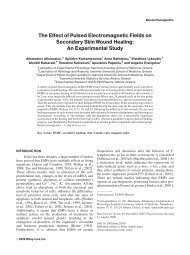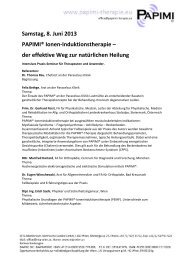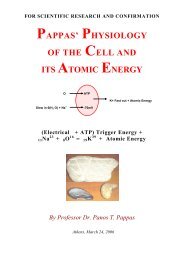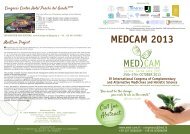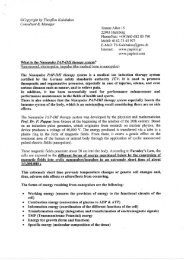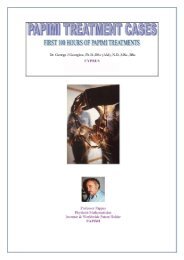Cases from private practices - Papimi
Cases from private practices - Papimi
Cases from private practices - Papimi
Create successful ePaper yourself
Turn your PDF publications into a flip-book with our unique Google optimized e-Paper software.
ML All I know is they put this ring on me, the machine makes a noise for 20 minutes or so, the<br />
ring gets a little warm--not really hot--so I know it's doing something, but I don't feel anything during the<br />
treatment.<br />
It's just that I feel so much better after the treatment. So what's happening inside me<br />
CW Okay. As you have been told, I'm a research scientist who has spent a greatdeal of time<br />
investigating the biological effects of electricity and magnetism. When I heard of this new Magnetic<br />
Oscillation Therapy being used on an experimental basis, I became interested and asked to see the system<br />
in operation. I was graciously invited to inspect the machine (we call it the "Magnetic Pulse Generator"<br />
or MPG, and told about some of the first case histories--including yours.<br />
ML Have there been many others<br />
CW Not yet. This system has only been approved for experimental use until enough<br />
experience and data has been gathered to apply for full approval by the Food and Drug Administration.<br />
As a result, only a few carefully selected patients have been admitted to the research program. I think you<br />
are the only one who has not had an opportunistic infection, but similarly remarkable results have been<br />
observed on the few other HIV+ patients they have treated so far. <strong>Cases</strong> of Kaposi's sarcoma,<br />
pneumocystis Carinii and AIDS-related diarrhea have been cleared up in remarkably short time, and in<br />
those cases an increase in T-cell count was also noted--along with a significant improvement in general<br />
health.<br />
ML Yes, I heard a little bit about that at the clinic. But how does it work<br />
CW Well, at first glance the MPG appears to have several effects: it kills bacteria, stops the<br />
growth of cancer cells, and increases the production of T-cells. But in the final analysis these may be all<br />
caused by the same basic mechanism.<br />
ML What's that<br />
CW You see, every living cell has its own tiny electrical system. We can actually measure the<br />
voltage of a cell, just like you measure the voltage of a car battery. We call this voltage the<br />
transmembrane potential, or TMP for short. This is the voltage between the inner and outer skin, or<br />
membrane of the cell. In a normal, healthy cell this is about 60 or 70 hundredths of a volt--60 or 70<br />
millivolts. When a cell is sick or injured, it cannot operate properly and it loses its charge. You might<br />
say its battery runs down.<br />
ML How does a cell get sick<br />
CW Oh, it could be infected with a parasitic microorganism, or cut off <strong>from</strong> its source of<br />
nutrients and blood supply to the point where it is starving. In fact, although "sick" is probably not the<br />
proper term for a third situation, a form of starvation is the basic mechanism of cell reproduction. You<br />
see, when a normal cell grows bigger and bigger, two things happen: its outer skin or membrane stretches<br />
and becomes thinner, and the ratio of volume to surface area increases to the point where it cannot absorb<br />
enough nutrients to sustain its bulk. It begins to starve and lose its ability to generate the electrical<br />
potential it needs for normal operation.<br />
ML Hmmm, yes, I think I can see that. Like a fat man on a thin man's diet.<br />
CW Precisely. And when the membrane voltage, the TMP falls by 80% or 85% to somewhere<br />
around 12 to 15 millivolts the starving cell--in a last attempt to survive--divides itself into two "sister"<br />
cells. The volume-to-surface ratios are greatly reduced, the membranes become thicker and more<br />
functional, nutrient requirements are lowered, the TMP bounces back to normal, and we have two healthy<br />
cells in place of one fat starving one.<br />
ML I think I'm getting a little confused. Now you are talking about a normal process of cell division,<br />
but what's that got to do with my case--or the other cases you mentioned<br />
50



